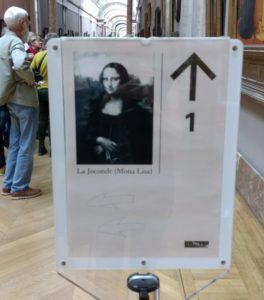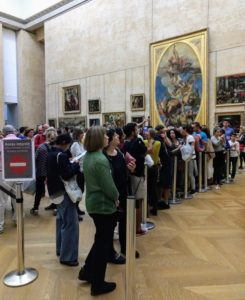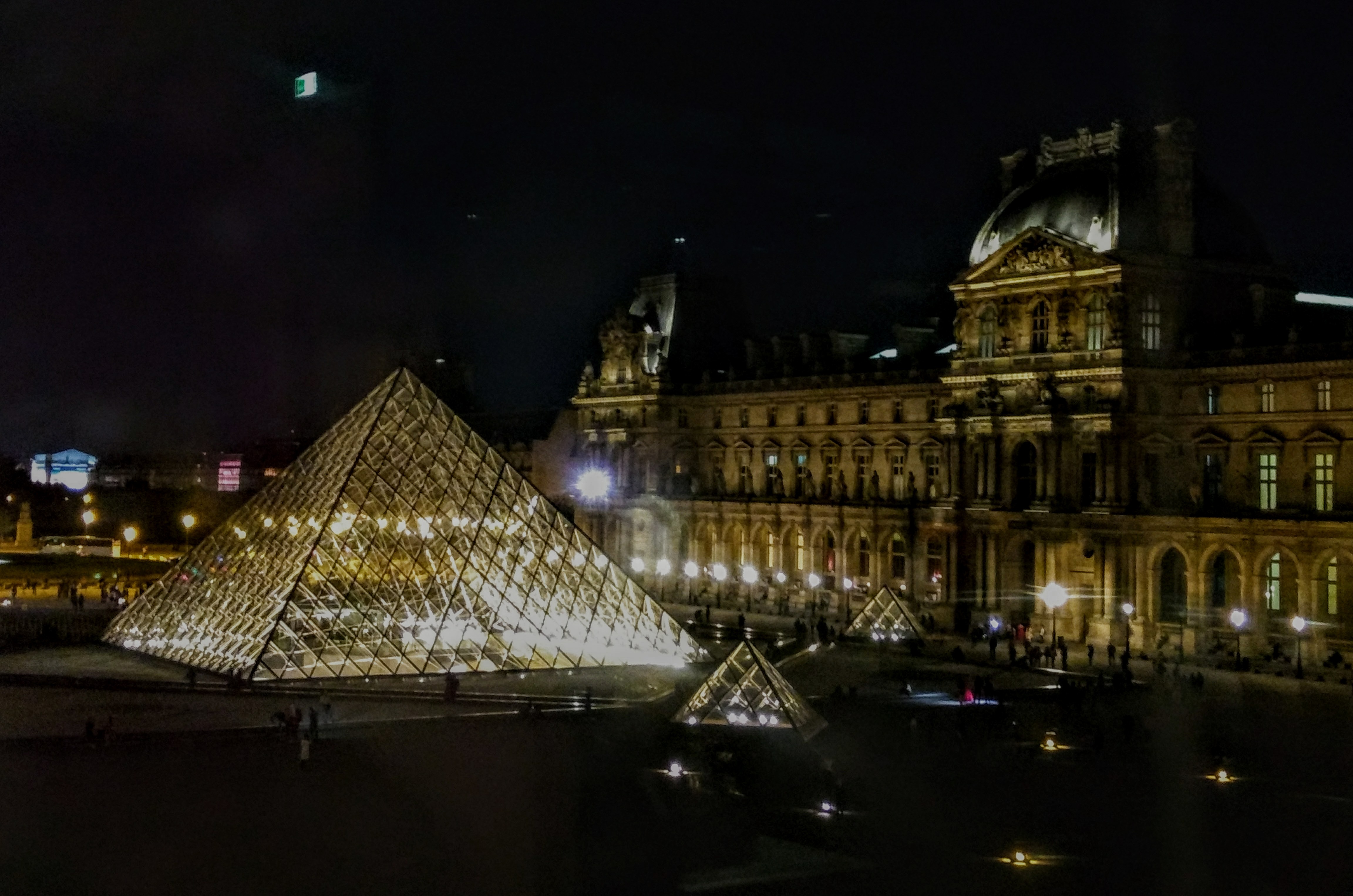I set off an alarm at the Louvre. I promise it wasn’t on purpose. I wasn’t trying to steal something, wasn’t playing keep away with a statue. No, I was simply reaching toward her eye, her eye, that desperate eye, and I got too close. The alarm came, an unexpected wail, and I immediately backed off. “I didn’t touch her,” I said, not even attempting to speak in French.
“It’s okay,” the museum worker said to me, reassuring. “It happens all the time.”
“It’s just…les yeux,” I say. “The eyes, they memorize me.”
It wasn’t the Mona Lisa that caused the chaos. Just one of my most treasured paintings I’ve ever seen, tucked away on Level 2 in 19th century French painters. I first discovered her several years ago, and on every trip back to Paris I go to the Louvre to visit her. If I’m being honest, I must confess that the Louvre is not my favorite museum, not even close; I find it too overwhelming and too crowded. But I always make a special trip to see those eyes.
I couldn’t remember the exact room she was in or the artist’s name or the title (something about an orphan). I had previously never taken a photo of her or even written down her name. But with some quick research I tracked down what I thought was my painting: “Jeune Orpheline au Cimetière” (“Young Orphan Girl at the Cemetery”). The picture I found online sort of looked like her. But there was something missing. The girl in the online photo looked flat. She didn’t look alive. She didn’t look desperate, isolated, hopeless. In person, though, the moment I walked into the room, the whites of her eyes hit me, and I knew I had found her. I spent thirty minutes in the room, just looking.

Going to the Louvre, it’s hard to not stumble upon the Mona Lisa at some point. Just follow the crowds. Can’t find them? There are dozens of signs with arrows pointing the way to one of the best known paintings in history. There are songs about her, books about her, movies about her. She has been both stolen and vandalized. Your photo have six strangers’ heads in it? Not a problem. In the gift shop, you can buy souvenirs of her face on everything from umbrellas to lip balm. You can even buy a Mona Lisa Rubik’s Cube. Her face is everywhere, but at what cost? In a 2009 New York Times article, then-museum director Henri Loyrette admitted that of the millions who visit the Louvre every year, “80 percent of the people only want to see the Mona Lisa.” In a museum that offers several miles of artwork spanning multiple floors, that’s a depressing thought.

Truthfully, I’ve always felt a bit sorry for the Mona Lisa. Perhaps it sounds strange to feel sympathy for a painting, but I do. Yes, she is a popular lady. La Jaconde is the most visited piece of art in the world, but in my eyes proportionately she’s also the least seen. This trip, as I stand in the room where she lives, silently observing the crowds, I notice that many people don’t really look at her. They instead take a quick glance and then stare at her through screens, aligning her frame in their frame before they click and leave, sometimes turning their backs on her to do a group selfie. Even if you want to spend time looking at her, she is protected behind bulletproof glass. In addition to the glass, between viewer and painting, there are two wooden barriers and finally a row of stanchions and belts. Plus, let’s not forget, she’s surrounded by a gazillion people. The closest you can get to her is about ten feet away and that’s only if you’re lucky enough (and patient enough) to work your way through the crowd.
I wonder, what does it feel like, to be under such scrutiny, every single day, every single year? To have the world’s eyes constantly turn toward yours? To have millions of strangers take snapshots of you to later show again and again to friends and relatives so they can say, “Hey look, I was there.”
“Watching the crowd is more entertaining than looking at her,” I overhear one visitor say.
Back in early January 2000, my friend Lori and I went to Paris over winter break and somehow we found ourselves alone in the room with La Jaconde. We had gone to the Louvre on one of the nights that it stays open late, plus it was winter, so the museum wasn’t crowded to begin with. Lori and I decided to use this to our advantage to see as much as we could, and we stayed until closing time (there was wine involved). We decided to see the Mona Lisa right before we left, and magically we were the only visitors there.

The room was so still. Weighty. Almost ghostlike. The sound of our breaths echoed against the high walls. And I swear I saw relief dance across the Mona Lisa’s smile. She was the woman loosening her bra clasp at the end of a long work day, removing her make-up with cotton balls and cold cream, slipping off her high heels to elevate her tired feet.
I won’t even attempt to crack the world’s fascination with the Mona Lisa after that visit, won’t try and break down the mystery of her expression. Scholars have debated her smile for decades, and it’s not something I can — or even want to — explain. But I do know that I’ve never felt the impulse to go back to visit her because I know I’ll probably never recapture that same, perfect moment again. So when I go to the Louvre, while I might inevitably pass by her room for a glimpse, I tend to spend my time alone on Level 2 with my orphan girl.
But still I wonder what the Mona Lisa thinks when the lights go off and the last visitor has left, when she is finally free from the gawks and stares and camera shutters. Is it amusement? Bewilderment? Joy? Calm? What does she feel when she’s no longer on display, no longer, at least temporarily, the object of the world’s gaze?







It really is bizarre. I had her to myself once too, in April of 2003. The US was in a tizzy about “Freedom Fries” and whatever else. I felt like the only American in Paris. Had the Louvre all to myself. Perfection.
I had some good “Freedom Fries” (rather: “des frites de la liberté”) yesterday.
I’m always happiest to be places at low season. Crowds stress me out too much!
Yeah, I don’t really get this endless obsession with Mona Lisa. If you ask me, it is not by a long shot Leonardo’s best piece of work anyway (though I confess, I have never seen it in the original, and apparently that makes some difference). I think it’s the Paris Hilton effect all over again: the picture has become famous for being famous. So you want to see it, because that’s what you do when you’re in the Louvre.
I think the Delacroix picture you talk about here is ten times better, but that’s just me. Anyway, I’m even more of a heretic than that: on the whole, I prefer still life. 🙂
She is more interesting in person, but I find it impossible to even consider that when surrounded by hordes of people snapping selfies. At least with my Delacroix painting I can sit there and really experience it from multiple angles.
I remember one time a few years ago, there was a strike (surprise, surprise) and so the Louvre was closed. I ran into an American mother and daughter who were just devastated that they wouldn’t get to go. I said, “It’s Paris. There are so many museums to see — and so many museums that are just as interesting, if not more interesting, than the Louvre.” But they didn’t want to go to the other museums. They wanted to go to the Louvre, and so they were going to go back to their hotel. So strange.